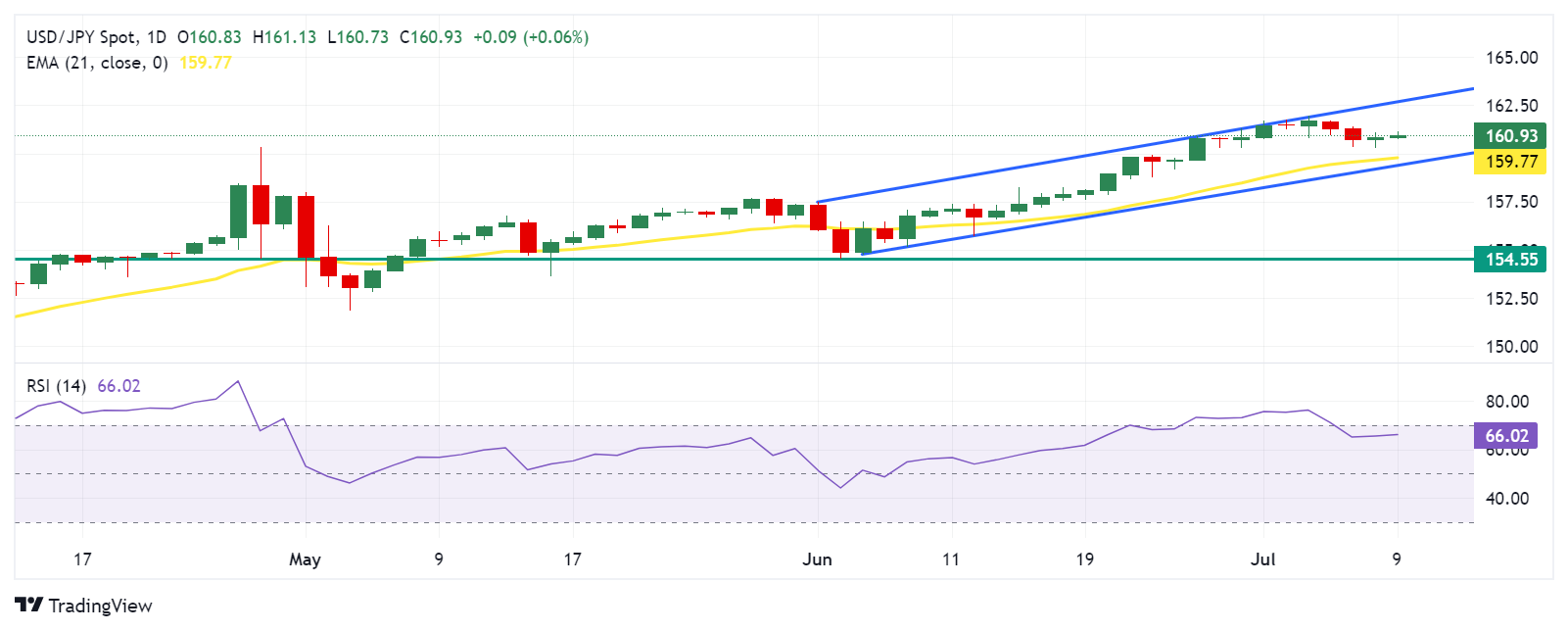Japanese Yen depreciates due to overseas asset purchases through NISA program

- The Japanese Yen struggles due to overseas asset purchases by Japanese individuals through the NISA program.
- The BoJ is set to evaluate a viable strategy for reducing its government bond purchases.
- Fed Chair Powell may deliver a comprehensive review of the economy and monetary policy to the US Congress on Tuesday.
The Japanese Yen (JPY) extends its losses for the second successive session on Tuesday. The minor improvement in the US Dollar (USD) underpins the USD/JPY pair. However, the JPY could limit its downside due to fears of intervention by Japanese authorities in the FX markets.
The Japanese Yen also struggles due to overseas asset purchases by Japanese individuals through the newly revamped tax-free investment scheme, the Nippon Individual Savings Account (NISA) program. According to Nikkei Asia, the scale of these purchases is expected to exceed the country’s trade deficit during the first half of this year.
US Treasury yields are under pressure amid rising speculation that the Federal Reserve (Fed) may reduce interest rates in September, potentially limiting the upside of the US Dollar. The CME’s FedWatch Tool indicates that rate markets price in a 76.2% probability of a rate cut in September, up from 65.5% just a week earlier.
Federal Reserve Chairman Jerome Powell will deliver “The Semiannual Monetary Policy Report” to the US Congress on Tuesday. Powell may provide a broad overview of the economy and monetary policy, with his prepared remarks being published ahead of his appearance on Capitol Hill.
Daily Digest Market Movers: Japanese Yen declines due to foreign outflows
- According to a Bloomberg report on Tuesday, the Bank of Japan is conducting three in-person meetings with banks, securities firms, and financial institutions over the next few days. The purpose of these meetings is to assess a feasible pace for scaling back its purchases of Japanese Government Bonds.
- Japan’s Ministry of Finance reported on Monday that Japanese investment trust management companies and asset management firms bought ¥6.16 trillion ($38 billion) more in offshore equities and investment fund shares than they sold during the first six months of the year.
- Rabobank FX analysts note that they expect USD/JPY to hold around the 160 level over the next month, with the pair easing back to 152 by year-end. “The US Dollar (USD) could remain under pressure in the coming weeks, allowing USD/JPY to stay close to 160.”
- On Monday, the Bank of Japan (BOJ) maintained its economic assessment for five of Japan’s nine regions in its latest ‘Sakura Report’. The assessment for two regions was raised, while it was lowered for another two regions in the report released on Monday. Regarding price trends, the BOJ noted that many regions report wage hikes spreading among smaller firms.
- Japan’s Current Account surplus extended its growth streak to the 15th month in May. The Ministry of Finance reported on Monday that the current account increased to ¥2,849.9 billion ($17.78 billion) in May, up from ¥2,050.5 billion in the previous month, surpassing market expectations of ¥2,450.0 billion.
- US Nonfarm Payrolls (NFP) increased by 206,000 in June, following a rise of 218,000 in May. This figure surpassed the market expectation of 190,000.
- The Minutes from the Federal Reserve’s June 11-12 monetary policy meeting, released on Wednesday, suggested that Fed officials were in a wait-and-see mode. “Some participants emphasized the Committee’s data-dependent approach, with monetary policy decisions being conditional on the evolution of the economy rather than being on a preset path.”
Technical Analysis: USD/JPY rises to near 161.00
USD/JPY trades around 161.00 on Tuesday. The pair remains within an ascending channel pattern, indicating a bullish inclination based on daily chart analysis. Additionally, the momentum indicator, the 14-day Relative Strength Index (RSI), remains above the 50 level, confirming the bullish trend.
The USD/JPY pair could test the key resistance at the upper boundary of the ascending channel near the level of 162.55. A breakout above this level might strengthen bullish sentiment, potentially driving the pair toward psychological resistance at 163.00.
On the downside, the USD/JPY pair may find immediate support around the 21-day Exponential Moving Average (EMA) at 159.78. A break below this level could exert pressure on the pair to test the lower boundary of the ascending channel around 159.40. A further decline below this channel support could lead the pair to navigate the vicinity around June’s low at 154.55.
USD/JPY: Daily Chart
Japanese Yen PRICE Today
The table below shows the percentage change of Japanese Yen (JPY) against listed major currencies today. Japanese Yen was the weakest against the Euro.
| USD | EUR | GBP | JPY | CAD | AUD | NZD | CHF | |
|---|---|---|---|---|---|---|---|---|
| USD | -0.03% | 0.02% | 0.11% | 0.01% | -0.03% | 0.07% | 0.08% | |
| EUR | 0.03% | 0.03% | 0.16% | 0.03% | 0.00% | 0.11% | 0.11% | |
| GBP | -0.02% | -0.03% | 0.10% | -0.00% | -0.01% | 0.08% | 0.07% | |
| JPY | -0.11% | -0.16% | -0.10% | -0.11% | -0.15% | -0.05% | -0.05% | |
| CAD | -0.01% | -0.03% | 0.00% | 0.11% | -0.05% | 0.08% | 0.06% | |
| AUD | 0.03% | -0.01% | 0.01% | 0.15% | 0.05% | 0.09% | 0.08% | |
| NZD | -0.07% | -0.11% | -0.08% | 0.05% | -0.08% | -0.09% | 0.00% | |
| CHF | -0.08% | -0.11% | -0.07% | 0.05% | -0.06% | -0.08% | -0.00% |
The heat map shows percentage changes of major currencies against each other. The base currency is picked from the left column, while the quote currency is picked from the top row. For example, if you pick the Japanese Yen from the left column and move along the horizontal line to the US Dollar, the percentage change displayed in the box will represent JPY (base)/USD (quote).
Bank of Japan FAQs
The Bank of Japan (BoJ) is the Japanese central bank, which sets monetary policy in the country. Its mandate is to issue banknotes and carry out currency and monetary control to ensure price stability, which means an inflation target of around 2%.
The Bank of Japan has embarked in an ultra-loose monetary policy since 2013 in order to stimulate the economy and fuel inflation amid a low-inflationary environment. The bank’s policy is based on Quantitative and Qualitative Easing (QQE), or printing notes to buy assets such as government or corporate bonds to provide liquidity. In 2016, the bank doubled down on its strategy and further loosened policy by first introducing negative interest rates and then directly controlling the yield of its 10-year government bonds.
The Bank’s massive stimulus has caused the Yen to depreciate against its main currency peers. This process has exacerbated more recently due to an increasing policy divergence between the Bank of Japan and other main central banks, which have opted to increase interest rates sharply to fight decades-high levels of inflation. The BoJ’s policy of holding down rates has led to a widening differential with other currencies, dragging down the value of the Yen.
A weaker Yen and the spike in global energy prices have led to an increase in Japanese inflation, which has exceeded the BoJ’s 2% target. Still, the Bank judges that the sustainable and stable achievement of the 2% target has not yet come in sight, so any sudden change in the current policy looks unlikely.
Information on these pages contains forward-looking statements that involve risks and uncertainties. Markets and instruments profiled on this page are for informational purposes only and should not in any way come across as a recommendation to buy or sell in these assets. You should do your own thorough research before making any investment decisions. FXStreet does not in any way guarantee that this information is free from mistakes, errors, or material misstatements. It also does not guarantee that this information is of a timely nature. Investing in Open Markets involves a great deal of risk, including the loss of all or a portion of your investment, as well as emotional distress. All risks, losses and costs associated with investing, including total loss of principal, are your responsibility. The views and opinions expressed in this article are those of the authors and do not necessarily reflect the official policy or position of FXStreet nor its advertisers. The author will not be held responsible for information that is found at the end of links posted on this page.
If not otherwise explicitly mentioned in the body of the article, at the time of writing, the author has no position in any stock mentioned in this article and no business relationship with any company mentioned. The author has not received compensation for writing this article, other than from FXStreet.
FXStreet and the author do not provide personalized recommendations. The author makes no representations as to the accuracy, completeness, or suitability of this information. FXStreet and the author will not be liable for any errors, omissions or any losses, injuries or damages arising from this information and its display or use. Errors and omissions excepted.
The author and FXStreet are not registered investment advisors and nothing in this article is intended to be investment advice.





